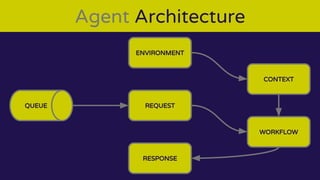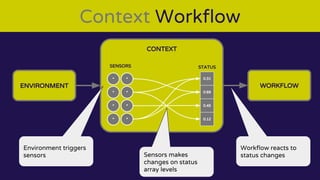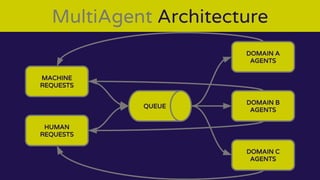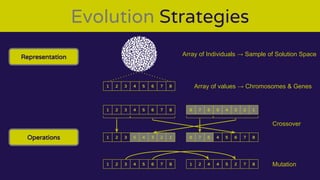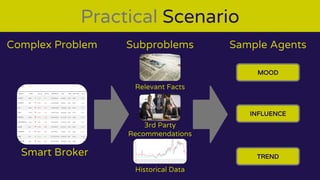Evolution strategies as brain of autonomous agents
- 1. Evolution Strategies as brain of Autonomous Agents Eduardo Sánchez Carballo @eduscarb
- 3. A colony of termites can build more than a single human
- 4. Divide & Conquer COMPLEX PROBLEM SUBPROBLEM A SUBPROBLEM B SUBPROBLEM C
- 5. Divide & Conquer COMPLEX PROBLEM SUBPROBLEM A SUBPROBLEM B SUBPROBLEM C REQUIRES HIGH COMPUTATIONAL POWER NOT ALWAYS PARALLEL APPROACH DIFFICULT TO MODEL AND PREPARE DATA
- 6. Divide & Conquer COMPLEX PROBLEM SUBPROBLEM A SUBPROBLEM B SUBPROBLEM C REQUIRES HIGH COMPUTATIONAL POWER NOT ALWAYS PARALLEL APPROACH DIFFICULT TO MODEL AND PREPARE DATA REQUIRES HIGH INITIAL ANALYSIS FOR DECOMPOSITION SUBPROBLEMS ARE EASIER TO MODEL AND PREPARE DATA
- 7. “An agent is an entity that functions continuously and autonomously in an environment in which other processes take place and other agents exist” Yoav Shoham - 1993
- 9. Context Workflow ENVIRONMENT CONTEXT * * * * * * * * 0.21 0.72 0.33 0.01 SENSORS STATUS WORKFLOW
- 10. Context Workflow ENVIRONMENT CONTEXT * * * * * * * * 0.21 0.72 0.33 0.01 SENSORS STATUS Environment triggers sensors Sensors makes changes on status array levels WORKFLOW Workflow reacts to status changes 0.31 0.69 0.45 0.12
- 11. MultiAgent Architecture QUEUE DOMAIN A AGENTS DOMAIN B AGENTS DOMAIN C AGENTS HUMAN REQUESTS MACHINE REQUESTS
- 12. MultiAgent Scalability DOMAIN A AGENTS ● Able to infer if request is from my domain ● Able to reroute other domains requests ● Request are forwarded and delegated to ensure performance ● Able to self clone ● Able to “talk” with underneath platform ● Able to self kill if no new requests are received This approach provides a true cooperative model for multiagent problem solving And a natural way to go for large scale complex problem solving
- 13. Evolution Strategies Representation Operations 1 2 3 4 5 6 7 8 Array of values → Chromosomes & Genes 1 2 3 4 5 6 7 8 Crossover 8 7 6 5 4 3 2 1 1 2 3 5 4 3 2 1 8 7 6 4 5 6 7 8 Mutation1 2 3 4 5 6 7 8 1 2 4 4 5 2 7 8 Array of Individuals → Sample of Solution Space
- 14. Functional Representation RNN ES ?(x) = sigmod(∑i (wi gi (x)+bi )) + x * + 2 y ?(x,y) = x + (x * (2 + y)) x Directed Graph Expression Tree
- 15. ES Alternatives Genetic Algorithm CMA-ES NES (PEPG) OPEN-AI ES ● Based on crossover ● Mutation is optional ● Good for specific problems ● Bad at scaling ● Based on mutation ● No crossover ● Good for gradient descent ● Scalable, but not designed for it ● Based on mutation ● Inspired on natural evolution ● Very fast training ● Stucks frequently on local optimum ● Based on CMA-ES ● No crossover ● Designed for scaling ● Not always able to find best solution
- 16. Actual Performance At the start, CMA-ES shows the ability to reach a very good solution in very few iterations At the end, all approaches are fairly good, and enough for most practical use cases TRAINING
- 17. Actual PerformanceTRAINING At the start, CMA-ES is slower than other approaches, that reaches local optima very quick, specially PEPG that takes less than 4s to get a fairly good solution But, soon, CMA-ES is able to reach better solution that any other.
- 18. Actual PerformanceEXECUTION ES RNN Typical execution time: 160ms For a 1000 node expression tree Typical execution time: 20sg For a 512 node RNN
- 20. Putting All Together ENVIRONMENT CONTEXT * * * * * * * * 0.21 0.72 0.33 0.01 SENSORS STATUS CMA-ES 0.31 0.69 0.45 0.12 REQUEST RESPONSE CMA-ES model will be reacting to both environment and requests CMA-ES will be saving historical data and self training automatically + x * + 2 y x
- 21. Practical Scenario Complex Problem Subproblems Smart Broker Relevant Facts Historical Data 3rd Party Recommendations Sample Agents MOOD INFLUENCE TREND
- 22. Conclusions ? Evolution Strategies offers a very good solutions for optimization problems ? Training times are in the order of seconds and execution in the order of milliseconds ? This allows frequent retraining with relatively low resource use ? Multiagent systems based on CMA-ES are massively parallelizable across heterogeneous clusters ? They are very useful in multiagent implementations to solve complex problems








